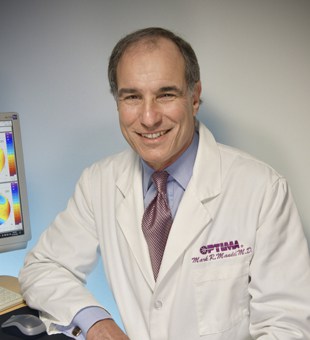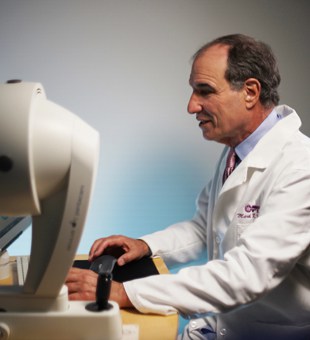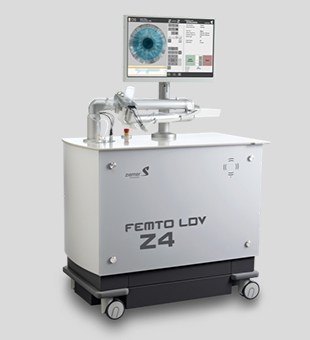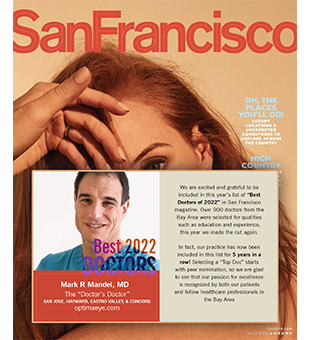Offices in Hayward, Castro Valley, Concord, & San Jose
Video: Cataracts & Lens Implant Choices
Due to advances in medical technology, we now have a number of choices for the type of lens implant which will be placed in the eye. Below is a summary of the choices. The physicians and staff at Optima are here to help you make the choice, but ultimately, the choice is up to the patient and the family.
- BOTH EYES ADJUSTED FOR DISTANCE VISION. The power of the intraocular lens for both eyes is adjusted for distance vision. Patients will need glasses for reading and for intermediate tasks such as the computer, dashboard, cell phone, and wristwatch, and other near and intermediate tasks. Because of how each eye heals, even those patients whose eyes are adjusted for distance vision may still need distance glasses for functions such as driving, T.V., movies, and golf.
- ONE EYE ADJUSTED FOR DISTANCE AND THE OTHER EYE ADJUSTED FOR NEAR (MONOVISION, BLENDED VISION). By using different implant powers for each eye, we can adjust the vision in one eye for distance and in the other eye for near tasks such as reading or using a computer. Some people currently achieve this with contact lenses. Even with this option, patients may still need glasses for distance vision, (especially night driving), and possibly for near. Most, but not all, patients can get used to having one eye adjusted for distance and the other eye adjusted for near. If you have high astigmatism, we can also use the toric lens to achieve monovision.
- FOR PATIENTS WITH HIGH AMOUNTS OF ASTIGMATISM. Astigmatism is when the eye is shaped more like a football than a basketball. There is a lens implant option called the “toric” IOL. This lens has the astigmatism incorporated into the implant (like your glasses). The advantage to this lens upgrade is that, because it significantly reduces the astigmatism, people are often much less dependent upon glasses following surgery for distance vision. However, unless we do monovision with the toric lens, glasses will be required for using a computer and reading.
- MULTIFOCAL IMPLANTS. Since 2003, we have been using multifocal implant lenses. This is the latest in implant technology. With this option, each eye receives a multifocal lens. The goal is that when looking at a distant object, patients can see well in the distance with both eyes. Also, patients can see well with both eyes when viewing intermediate targets such as the dashboard, a cell phone, a computer, or a wristwatch. Often, near targets such as menus and the newspaper can also be seen more clearly than with the standard lens implant. However, for small print, reading glasses will be necessary. Although most patients with these implants are glasses-free most of the time, it is important to realize that these lenses are not perfect. Occasionally distance and/or near glasses are required. This is the best option for patients who wish to have as “natural” vision as possible. Although we strive for glasses-free vision, these lenses and the healing of the human eye are never perfect and occasionally the use of glasses or corrective laser surgery may be necessary. More light maybe required while reading and some patients may see glare, halos, or starbursts while driving at night.
- LIGHT ADJUSTABLE LENS. The most high technology lenses available today are called the Light Adjustable Lens (LAL). Approximately four weeks after surgery, using an ultraviolet light delivery system, we fine-tune and micro-adjust the lens power to the patient’s visual needs. We typically leave the dominant eye for the full distance and the non-dominant eye slightly near such that patients are able to see distance, computer, cellphone, dashboard and near without glasses. Also, because of the technology, glare and halo is exceptionally rare. Although this lens works exceptionally well for everyone, this is absolutely the best choice for patients who have had prior LASIK or PRK and some patients with prior RK.
ORA – Optiwave Refractive Analysis
After the cloudy lens (cataract) has been removed, you can elect to have an additional confirmatory measurement with a real-time wavefront analyzer to assess and refine the exact measurements of the eye to ensure the most accurate lens implant power. This helps us to hit the target implant power more accurately without the cataract impeding the measurement. This leads to a better opportunity to refine and customize the implant power to your individual eye.
PRIOR CORRECTIVE SURGERY. Patients who have had prior LASIK, PRK, or RK will require additional pre-operative testing, measurements, and computer programs to determine the power of any lens implanted at the time of cataract surgery and also the use of the intra-operative ORA test to help refine our implant measurements which helps us to better achieve our visual target more accurately. Accordingly, there is an additional charge per eye for these additional measurements. This charge is included in the cost of a multifocal or toric implant. The cost of a LASIK or PRK touch-up if deemed to be safe and effective by Dr. Mandel is also included in this price.
Cost of Cataract Surgery
Medicare and insurance companies pay for the removal of the cataract and the standard distance implant. However, they do not pay for the upgrade for the premium implants (multifocal, toric) or for the LenSx laser procedure or ORA procedures.
We hope that this brief summary will help you to make a decision as to which implant you desire. As always, never hesitate to ask any of the physicians or staff any question at any time. We are committed to ensuring that you have the best possible outcome from your cataract surgery.
Why Choose Mark Mandel for Your Cataract Surgery?
Mark Mandel, MD, is one of the most experienced cataracts surgeons in Northern California, having performed cataract surgery on tens of thousands of patients as well as hundreds of eye doctors and their families who trust him for his surgical skill and knowledge. As an experienced Bay Area cataract surgeon, Dr. Mandel can walk you through the procedure and help you decide which lens implant will best suit your lifestyle. If you elect to have cataract surgery with Dr. Mandel, you have an extremely high chance of experiencing greatly improved vision.
Our Patients Say It Best – A Thank You For Rediscovering The World. . .
Recently, I had cataract surgery…a painless, brilliant procedure that left me with razor sharp vision. Of course, I thank my surgeon, Dr. Mark Mandel. And, I should mention, this is the third time I am thanking him!
Jann Yanehiro, cataract surgery patient
As an optometrist, I appreciate the value of precise vision and am aware of the risks of cataract surgery. When I needed cataract surgery, I chose Dr. Mandel to perform my procedure. I now routinely share my story with my patients in need of surgery and can attest to Dr. Mandel’s exceptional expertise based on my own personal experience and great outcome.
Brian Elliott, O.D.
Optometrist (Modesto)




